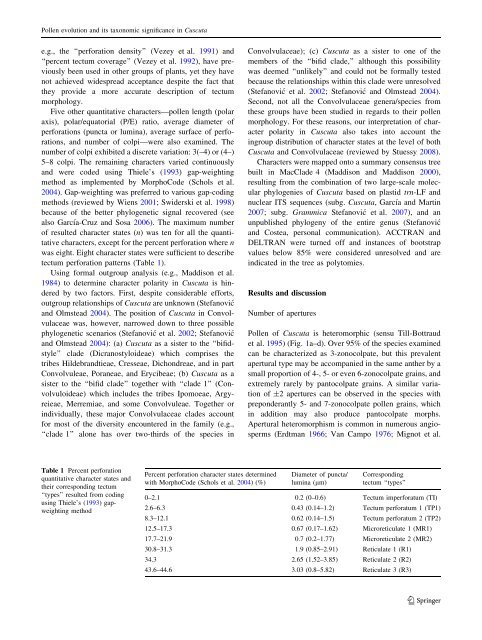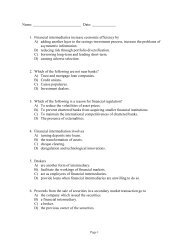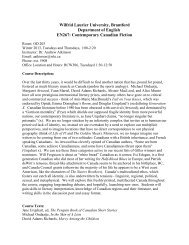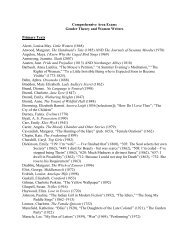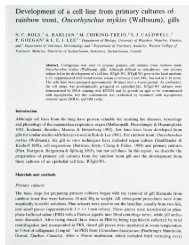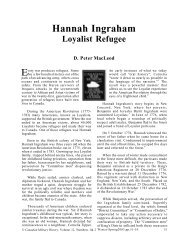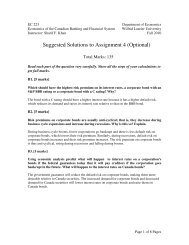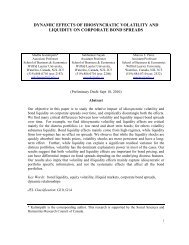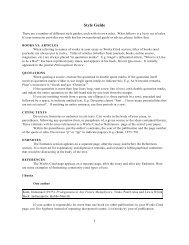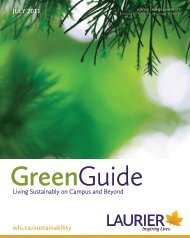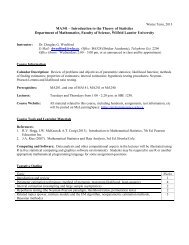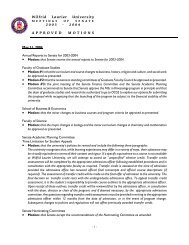Pollen evolution and its taxonomic significance in Cuscuta (dodders ...
Pollen evolution and its taxonomic significance in Cuscuta (dodders ...
Pollen evolution and its taxonomic significance in Cuscuta (dodders ...
You also want an ePaper? Increase the reach of your titles
YUMPU automatically turns print PDFs into web optimized ePapers that Google loves.
<strong>Pollen</strong> <strong>evolution</strong> <strong>and</strong> <strong>its</strong> <strong>taxonomic</strong> <strong>significance</strong> <strong>in</strong> <strong>Cuscuta</strong><br />
e.g., the ‘‘perforation density’’ (Vezey et al. 1991) <strong>and</strong><br />
‘‘percent tectum coverage’’ (Vezey et al. 1992), have previously<br />
been used <strong>in</strong> other groups of plants, yet they have<br />
not achieved widespread acceptance despite the fact that<br />
they provide a more accurate description of tectum<br />
morphology.<br />
Five other quantitative characters—pollen length (polar<br />
axis), polar/equatorial (P/E) ratio, average diameter of<br />
perforations (puncta or lum<strong>in</strong>a), average surface of perforations,<br />
<strong>and</strong> number of colpi—were also exam<strong>in</strong>ed. The<br />
number of colpi exhibited a discrete variation: 3(–4) or (4–)<br />
5–8 colpi. The rema<strong>in</strong><strong>in</strong>g characters varied cont<strong>in</strong>uously<br />
<strong>and</strong> were coded us<strong>in</strong>g Thiele’s (1993) gap-weight<strong>in</strong>g<br />
method as implemented by MorphoCode (Schols et al.<br />
2004). Gap-weight<strong>in</strong>g was preferred to various gap-cod<strong>in</strong>g<br />
methods (reviewed by Wiens 2001; Swiderski et al. 1998)<br />
because of the better phylogenetic signal recovered (see<br />
also García-Cruz <strong>and</strong> Sosa 2006). The maximum number<br />
of resulted character states (n) was ten for all the quantitative<br />
characters, except for the percent perforation where n<br />
was eight. Eight character states were sufficient to describe<br />
tectum perforation patterns (Table 1).<br />
Us<strong>in</strong>g formal outgroup analysis (e.g., Maddison et al.<br />
1984) to determ<strong>in</strong>e character polarity <strong>in</strong> <strong>Cuscuta</strong> is h<strong>in</strong>dered<br />
by two factors. First, despite considerable efforts,<br />
outgroup relationships of <strong>Cuscuta</strong> are unknown (Stefanović<br />
<strong>and</strong> Olmstead 2004). The position of <strong>Cuscuta</strong> <strong>in</strong> Convolvulaceae<br />
was, however, narrowed down to three possible<br />
phylogenetic scenarios (Stefanović et al. 2002; Stefanović<br />
<strong>and</strong> Olmstead 2004): (a) <strong>Cuscuta</strong> as a sister to the ‘‘bifidstyle’’<br />
clade (Dicranostyloideae) which comprises the<br />
tribes Hildebr<strong>and</strong>tieae, Cresseae, Dichondreae, <strong>and</strong> <strong>in</strong> part<br />
Convolvuleae, Poraneae, <strong>and</strong> Erycibeae; (b) <strong>Cuscuta</strong> as a<br />
sister to the ‘‘bifid clade’’ together with ‘‘clade 1’’ (Convolvuloideae)<br />
which <strong>in</strong>cludes the tribes Ipomoeae, Argyreieae,<br />
Merremiae, <strong>and</strong> some Convolvuleae. Together or<br />
<strong>in</strong>dividually, these major Convolvulaceae clades account<br />
for most of the diversity encountered <strong>in</strong> the family (e.g.,<br />
‘‘clade 1’’ alone has over two-thirds of the species <strong>in</strong><br />
Convolvulaceae); (c) <strong>Cuscuta</strong> as a sister to one of the<br />
members of the ‘‘bifid clade,’’ although this possibility<br />
was deemed ‘‘unlikely’’ <strong>and</strong> could not be formally tested<br />
because the relationships with<strong>in</strong> this clade were unresolved<br />
(Stefanović et al. 2002; Stefanović <strong>and</strong> Olmstead 2004).<br />
Second, not all the Convolvulaceae genera/species from<br />
these groups have been studied <strong>in</strong> regards to their pollen<br />
morphology. For these reasons, our <strong>in</strong>terpretation of character<br />
polarity <strong>in</strong> <strong>Cuscuta</strong> also takes <strong>in</strong>to account the<br />
<strong>in</strong>group distribution of character states at the level of both<br />
<strong>Cuscuta</strong> <strong>and</strong> Convolvulaceae (reviewed by Stuessy 2008).<br />
Characters were mapped onto a summary consensus tree<br />
built <strong>in</strong> MacClade 4 (Maddison <strong>and</strong> Maddison 2000),<br />
result<strong>in</strong>g from the comb<strong>in</strong>ation of two large-scale molecular<br />
phylogenies of <strong>Cuscuta</strong> based on plastid trn-LF <strong>and</strong><br />
nuclear ITS sequences (subg. <strong>Cuscuta</strong>, García <strong>and</strong> Mart<strong>in</strong><br />
2007; subg. Grammica Stefanović et al. 2007), <strong>and</strong> an<br />
unpublished phylogeny of the entire genus (Stefanović<br />
<strong>and</strong> Costea, personal communication). ACCTRAN <strong>and</strong><br />
DELTRAN were turned off <strong>and</strong> <strong>in</strong>stances of bootstrap<br />
values below 85% were considered unresolved <strong>and</strong> are<br />
<strong>in</strong>dicated <strong>in</strong> the tree as polytomies.<br />
Results <strong>and</strong> discussion<br />
Number of apertures<br />
<strong>Pollen</strong> of <strong>Cuscuta</strong> is heteromorphic (sensu Till-Bottraud<br />
et al. 1995) (Fig. 1a–d). Over 95% of the species exam<strong>in</strong>ed<br />
can be characterized as 3-zonocolpate, but this prevalent<br />
apertural type may be accompanied <strong>in</strong> the same anther by a<br />
small proportion of 4-, 5- or even 6-zonocolpate gra<strong>in</strong>s, <strong>and</strong><br />
extremely rarely by pantocolpate gra<strong>in</strong>s. A similar variation<br />
of ±2 apertures can be observed <strong>in</strong> the species with<br />
preponderantly 5- <strong>and</strong> 7-zonocolpate pollen gra<strong>in</strong>s, which<br />
<strong>in</strong> addition may also produce pantocolpate morphs.<br />
Apertural heteromorphism is common <strong>in</strong> numerous angiosperms<br />
(Erdtman 1966; Van Campo 1976; Mignot et al.<br />
Table 1 Percent perforation<br />
quantitative character states <strong>and</strong><br />
their correspond<strong>in</strong>g tectum<br />
‘‘types’’ resulted from cod<strong>in</strong>g<br />
us<strong>in</strong>g Thiele’s (1993) gapweight<strong>in</strong>g<br />
method<br />
Percent perforation character states determ<strong>in</strong>ed<br />
with MorphoCode (Schols et al. 2004) (%)<br />
Diameter of puncta/<br />
lum<strong>in</strong>a (lm)<br />
Correspond<strong>in</strong>g<br />
tectum ‘‘types’’<br />
0–2.1 0.2 (0–0.6) Tectum imperforatum (TI)<br />
2.6–6.3 0.43 (0.14–1.2) Tectum perforatum 1 (TP1)<br />
8.3–12.1 0.62 (0.14–1.5) Tectum perforatum 2 (TP2)<br />
12.5–17.3 0.67 (0.17–1.62) Microreticulate 1 (MR1)<br />
17.7–21.9 0.7 (0.2–1.77) Microreticulate 2 (MR2)<br />
30.8–31.3 1.9 (0.85–2.91) Reticulate 1 (R1)<br />
34.3 2.65 (1.52–3.85) Reticulate 2 (R2)<br />
43.6–44.6 3.03 (0.8–5.82) Reticulate 3 (R3)<br />
123


